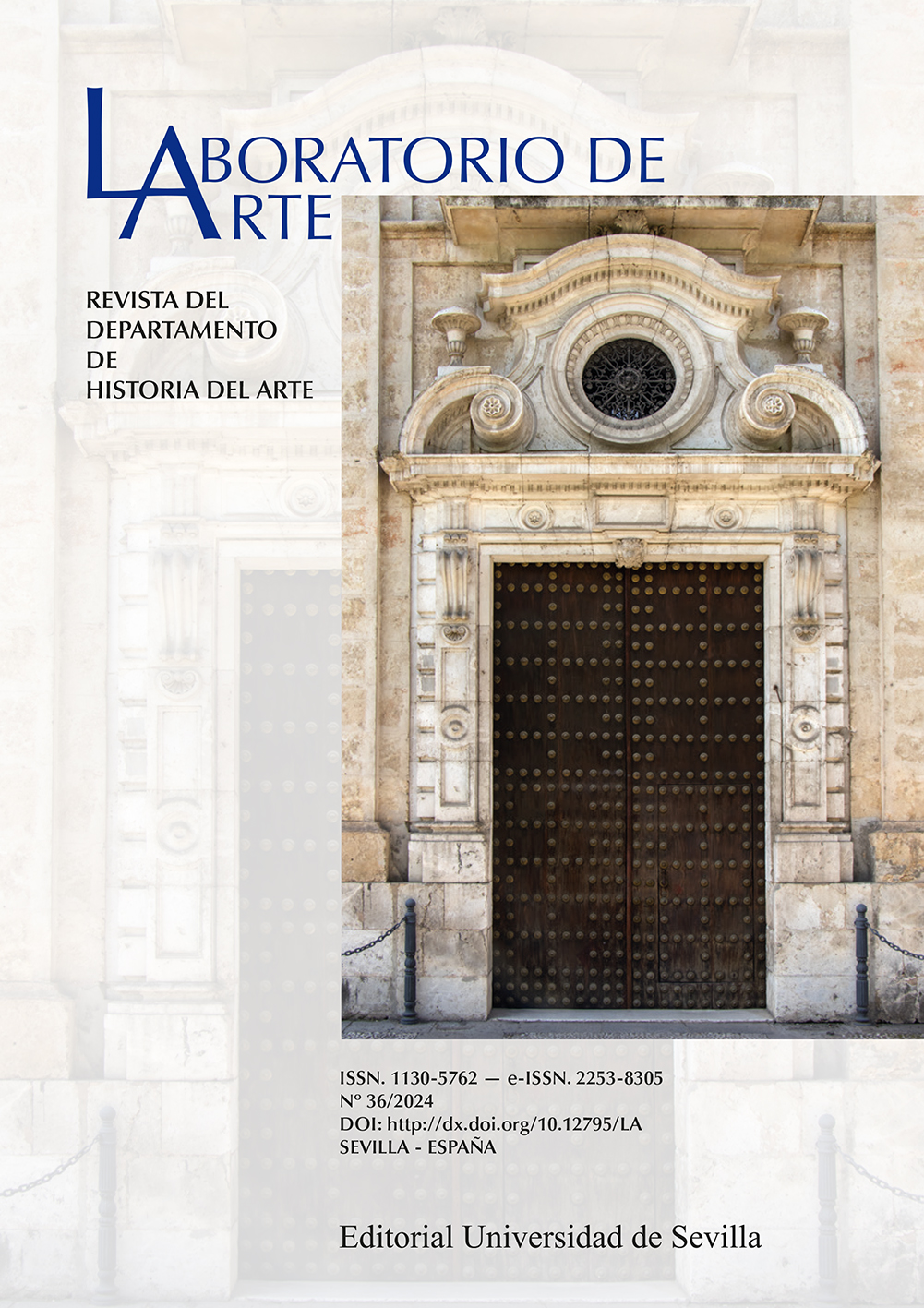What to do when the sea takes care of our pewter and brass?
DOI:
https://doi.org/10.12795/LA.2024.i36.06Keywords:
Art History, shipwreck, metal objects, Modern Age, Esposende (Portugal)Abstract
This article deals with the study of the collection of metal objects in a collection resulting from the discovery of a shipwreck from the Modern Age. Through the inventory of the objects under study, a formal, functional, and social analysis was developed. The aim is to highlight the scarce study dedicated to brass objects and, with special emphasis, pewter objects in Portugal, in addition to dissecting the methodologies used internationally and documenting the discrepancy of information between the different scientific contexts that have been dedicated to the subject.
Downloads
References
Almeida, Ana et al. 2017. “O naufrágio quinhentista de Belinho, Esposende. Resultados preliminares”. Al-madan II 21 (3): 80-95.
Almeida, Ana et al. 2022. “The Belinho 1 Shipwreck, Esposende, Portugal”. En Heritage and the Sea. Editado por Ana Crespo Solana, Felipe Castro y Nigel Nayling, 119-144. Cham: Springer Nature Switzerland.
Barros, Amândio. 2016. “Breve Relação Do Naufrágio Do Navio Nossa Senhora Da Rosa, Perdido Através De Esposende Em 1577. O Navio De Belinho?”. En A gestão de recursos florestais portugueses na construção naval da dade Moderna: História e Arqueologia, editado por Rosa Gomes y Mario Gomes, 51-60. Lisboa: Instituto de Arqueologia e Paleociências.
Bell, Malcom. 1906. Old Pewter. Londres: George Newnes Limited.
Bettencourt, José et al. O navio de Belinho: relatório de avaliação preliminar efectuada pelo CHAM em Junho de 2014. Lisboa: Centro de História d’Aquém e d’Além-Mar.
Boavida, Carlos. 2011. “Artefactos Metálicos do Castelo de Castelo Branco (Portugal)”. Açafa On Line 4: 2-45.
Boavida, Carlos. 2016. “Objectos de uso pessoal medievais e modernos no castelo de Castelo Branco”. En II Congresso Internacional de Arqueologia da Região de Castelo Branco. coordinado por Rafael Vilaça, 391-405. Castelo Branco: RVJ editores.
Bonhams. 2010. Pewter, including a Private Collection. Chester: Bonhams.
Borntraeger, A. 1950. “Pewter in Art”. The Bulletin – The Pewter Collectors’ Club of America II (8): 146-152.
Brigadier, Sarah. 2000. “The Artifacts from São Julião da Barra”. The INA Quarterly 27 (4): 10-12.
Brigadier, Sarah. 2002. The artifact assemblage from the Pepper Wreck. Texas: Texas A&M University.
Burgess, Fred. 1921. Silver: Pewter: Sheffield Plate. Londres: George Routledge & Sons, LTD.
Castro, Filipe. 2000. Pewter Plates from São Julião da Barra, a 17th century site at the mouth of the Tagus river, Lisbon, Portugal. Texas: College Station.
Castro, Filipe. 2015. Belinho 1 Shipwreck: Timber Catalogue. [S.l.]: For Sea Discovery; Instituto de História Contemporânea.
Coterell, Howard. 1934. “Some Early Pewter Candlesticks”. The Connoisseur XVI: 105-109.
Curle, Alexander. 1926. “Domestic candlesticks from the fourteenth to the end of the eighteenth century”. Proceedings of the Society of Antiquaries of Scotland 60: 183-214.
Fonseca, Patrícia. 2017. “História Submersa”. Visão, 6 de julio, 36-45.
Forsyth, Hazel, Jan Gadd y David Hall. 2017. The Museum of London’s Pewter Collection. Londres: Museum of London, The Pewter Society.
Gadd, Jan. 1998. “Hallmarks – fake and pseudo silver marks on pewter in 1636 and later”. The Journal of The Pewter Society 11 (3).
Gadd, Jan. 1999. “The Crowned Rose as a secondary touch on pewter”. The Journal of The Pewter Society 12 (2).
Gadd, Jan. 2001. “English Pewter Candlesticks of the Baroque Period,”. The Pewter Society Journal 14: 21-30.
Gadd, Jan et al. 2000. Arlington Court: The Pewter Collection. [S.l.]: The Pewter Society.
Gotelipe-Miller, Shirley. 1990. Pewter and Pewterers from Port Royal, Jamaica: Flatware before 1692. Texas: Texas A&M University.
Hagnauer, Maximilian. 1948. “Touchmarks on swiss pewter”. The Bulletin – The Pewter Collectors’ Club of America II (3): 49-52.
Hayward, Peter y Mike Marsden. 2015. “English Porringers post-1650: Part 1”. Journal of the Pewter Society Autunn 2015: 2-30.
Hayward, Peter y Mike Marsden. 2016. “English Porringers post-1650: Part 2”. En: Journal of the Pewter Society Spring 2016: 2-30.
Herradón, Antonia. 2008. “Las hebillas, joyas olvidadas”. Indumenta. Revista del Museo del Traje 1: 104-125.
Herradón, Antonia. 2018a. “Joyería modernista. Hebillas y broches de cinturón”. En Estudios de Platería San Eloy 2018, coordinado por Jesús Rivas Carmona e Ignacio García Zapata, 263-278. Murcia: Editum.
Herradón, Antonia. 2018b. “Las hevillas en los Llibres de passanties”. En La joya en el Arte y el Arte en la joya. Actas del III Congreso Europeo de Joyería, coordinado por Montse Gumá, 209-219. Barcelona: Museo Nacional de Arte de Cataluña.
Hintze, Erwin. 1921a. Die deutschen zinngiesser und ihre marken band I: Sächsische zinngiesser. Leipzig: Hiersemann.
Hintze, Erwin. 1921b. Die deutschen zinngiesser und ihre marken band II: Nürnberger zinngiesser. Leipzig: Hiersemann.
Hintze, Erwin. 1923. Die deutschen zinngiesser und ihre marken band III: Norddeutsche zinngiesser. Leipzig: Hiersemann.
Hintze, Erwin.1926. Die deutschen zinngiesser und ihre marken band IV: Schlesische zinngiesser. Leipzig: Hiersemann.
Hintze, Erwin. 1927. Die deutschen zinngiesser und ihre marken band V: Süddeutsche zinngiesser. Leipzig: Hiersemann.
Hintze, Erwin. 1928. Die deutschen zinngiesser und ihre marken band VI: Süddeutsche zinngiesser. Leipzig: Hiersemann.
Hintze, Erwin. 1931. Die deutschen zinngiesser und ihre marken band VII: Süddeutsche zinngiesser. Leipzig: Hiersemann.
Homer, Ronald. 1980. “Base Metal Spoons”. Antique Collecting, 14-16.
Kulesz, Aleksandra y Jakub Michalik. 2020. “Modern Shoe Buckles from Archeological Research In Gniew and Piaseczno (Pomerania Province, Poland)”. Acta Universitatis Lodziensis Folia Archeologica 35: 151-165.
Massé, H. 1909. “Some notes on the recent pewter exhibition in Cliford’s”. The Connoisseur, 115-119.
Massé, Henri. 1910. Pewter Plate. Londres: George Bell and Sons.
Massé, Henri. 1915. Chats on Old Pewter. Nova Iorque: Frederick A. Stokes Company publishers.
Massé, Henri. 1921. The Pewter Collector: A Guide to English Pewter with some Reference to Foreign Work. Londres: Herbert Jenkins Limited.
Martins, Adolfo, Filipe Castro y Nigel Nayling. 2017. “Belinho 1: Registo e Análise Provisória às Madeiras do Navio”. En Árvores, Barcos e Homens na Península Ibérica (Séculos XVI-XVII), editado por Rosa Valera Gomes, Rosa y Koldo Trápaga Monchet, 181-192. Navarra: Instituto de arqueologia e Paleociências; Instituto de História Contemporânea.
Martins, Joana. 2010. Pratos e Bacias de Latão dos Séculos XV-XVI de Temática Religiosa da Casa Museu Guerra Junqueiro. Porto: Faculdade de Letras da Universidade do Porto. Dissertação de Mestrado.
Michaelis, Ron. 1949a. “English Pewter Porringers – Part I”. Apollo, julho, 23-26.
Michaelis, Ron. 1949b. “English Pewter Porringers – Part II”. Apollo, agosto, 46-48.
Michaelis, Ron. 1949c. “English Pewter Porringers – Part III”. Apollo, setembro, 81-84.
Michaelis, Ron. 1949d. “English Pewter Porringers – Part IV”. Apollo, outubro, 99-102.
Mundey, Richard. 1991. Pewter Hallmarks. Londres: The Pewter Society.
Naufrágio da praia do Belinho (Esposende): Programa para um projecto arqueológico integrado. 2015.
Neate, Richard. 1928. “English Pewter Candlesticks of the Seventeenth Century”. The Book of Antiques, 90-93.
Neish, Patricia. 2018. The Neish Pewter Collection. A Catalogue by Patricia Neish. Stirling: The Stirling Smith.
North, Anthony.1999. Pewter at the Victoria and Albert Museum. Londres: V&A Publications.
Price, Hilton. 1908. Old Base Metal Spoons with Illustrations and Marks. Londres: B. T. Bastford, 94, High Holborn.
Raymond, Percy. 1947. “The Skerry Paten”. The Bulletin – The Pewter Collectors’ Club of America II (2) 35-38.
Raymond, Percy. 1949. “Influence of English on American Pewter”. The Bulletin –The Pewter Collectors’ Club of America II (6): 109-118.
Redman, William. 1903. Handbook of Information on Pewter and Sheffield Plate with full particular of touch marks, marker’s marks, etc. Bradford: Price.
Ricketts, Carl y John Douglas. 1994. “The use of verfication marks to identify pewterers”. The Journal of The Pewter Society.
Ricketts, Carl. 2007. “On the origins of touchmarks II”. The Journal of The Pewter Society 27: 18.
Ricketts, Carl. 2008. “On the origins of touchmarks III”. The Journal of The Pewter Society 28.
Roberts, Martin. 2012a. “The Punta Cana Pewter Wreck: the earliest pewter known in the Americas”. The Pewter Collectors’ Club of America INC. – The Bulletin 14 (7): 4-19.
Roberts, Martin. 2012b. “The Punta Cana Wreck”. Journal of the Pewter Society, outono, 47-51.
Roberts, Martin. 2013. The Punta Cana Pewter Wreck. Pewter: Origin, Styles, Makers & Commerce. Doncaster: el autor.
Soulat, Jean y John Bry, John. 2019. “Archaeology Of Piracy Between Caribbean Sea And The North American Coast Of 17th And 18th Centuries: Shipwrecks, Material Culture And Terrestrial Perspectives”. Journal of Caribbean Archeology 19: 68-103.
Sousa, Ana. 1997. Ourivesaria Estampada e Lavrada: Uma Técnica Milenar num Oficina de Gondomar. Porto: Faculdade de Letras da Universidade do Porto.
Sousa, Ana. 2010. Tyolo da prata (…), do arame, estanho e ferro (…), latam cobre e cousas meudas… Objectos litúrgicos em Portugal (1478-1571). Porto: Faculdade de Letras da Universidade do Porto.
Teixeira, André y Luís Gil. 2012. “Cada Botão Sua Casaca. Indumentária recuperada nas escavações arqueológicas da fragata Santo António de Taná, Naufragada em Mombaça em 1697”. En Velhos e Novos Mundos. Estudos de Arqueologia Moderna, coordinado por André Teixeira y José António Bettencourt, vol. 2, 671-682. Lisboa: Centro de História de Além-Mar.
Van Zeller, Rolando. 1985. Estanhos portugueses. Porto: Civilização.
Wadley, Catheryn. 1985. Historical analysis of pewter spoons recovered from the sunken city of Port Royal, Jamaica. Texas: Texas A&M University.
Weinstein, Rosemary. 2011. The Archeology of Pewter Vessels in England 1200-1700: A Study of Form and Usage. Durham: Universidade de Durham.
Published
Issue
Section
License
Copyright (c) 2024 LABORATORIO DE ARTE

This work is licensed under a Creative Commons Attribution-NonCommercial-ShareAlike 4.0 International License.
Accepted 2024-02-17
Published 2024-10-06










